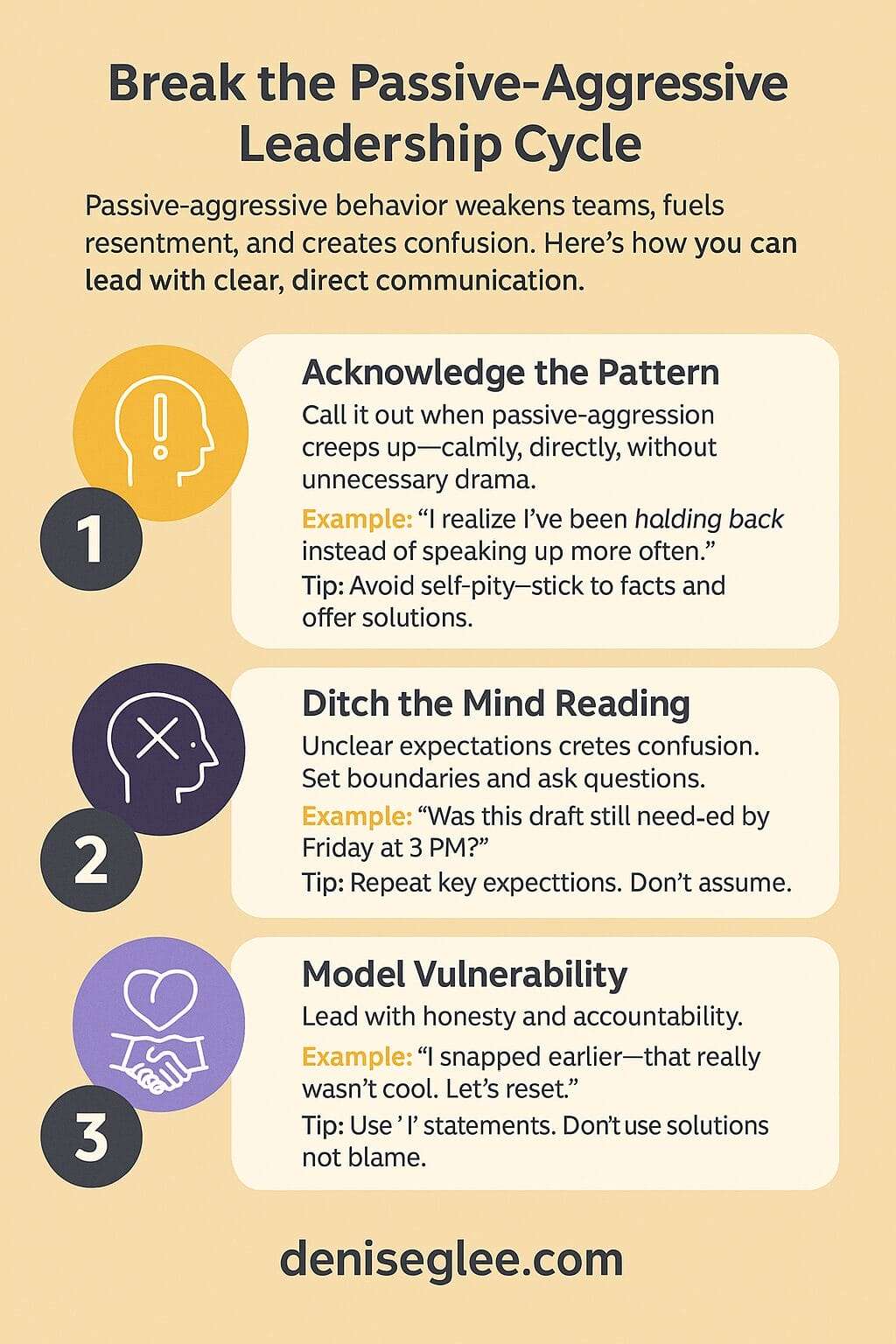
Silent Killers: The Hidden Toll of Passive-Aggressive Leadership
- Updated: October 23, 2025
As a healing and leadership coach, I’ve worked with leaders who have unwittingly created toxic environments with passive-aggressive behavior.
Picture this: a workplace where everyone smiles at the boss in meetings but rolls their eyes the moment they leave the room. Where deadlines mysteriously vanish, and “team players” sabotage projects with a grin.
This isn’t just something you see on TV—it’s happening in real life. Toxic work environments drain morale, but they cost your business far more than just energy. They drain resources, reduce productivity, and increase turnover.
If you’re a leader, this is your wake-up call: Passive-aggressive behaviors are silently sabotaging your team. But here’s the good news: it’s possible to change, and it starts with you. We’ll break down why passive-aggressive leadership happens, how it harms your team, and most importantly—how to stop it.
Ready to make a difference in your organization? Let’s dive in.
Your Path to Leadership Clarity: What’s Ahead
How Passive-Aggressive Leadership Hurts Office Productivity
Reason #1: It is Costly
Passive-aggressive behavior isn’t just annoying—it’s expensive. Studies show that workplaces lose over $37 billion yearly in the U.S. alone because of productivity drains like silent treatments, procrastination, and sarcasm. Imagine what your company could do with even a slice of that cash!

Reason #2: It Hurts Office Productivity
A passive-aggressive leader is someone who is either unwilling or unable to communicate their wants and needs clearly, concisely, and consistently. Yes, love—you need all 3Cs in place if you want your team to not only understand what to do but actually enjoy doing it. Without them? Expect nothing but confusion, frustration, and wasted time.
Let’s break down why this trifecta matters for productivity:
- Clearly – When you’re transparent and honest, people actually understand your vision and can get behind it. They might even build on your idea and make it better.
- Concisely – No rambling, long-winded explanations filled with unnecessary details. You’re not making people work overtime just to understand what you want. This keeps everyone focused on what truly matters.
- Consistently – No surprises. No shifting priorities based on your mood. Your team doesn’t have to walk on eggshells, wondering if today’s plan will be thrown out tomorrow.

If you don’t have the 3Cs locked down, here’s what you can expect:
- ❌Lower morale (Imagine working with a human raincloud.)
- ❌More conflicts (Hint: Eye-rolling isn’t a conflict resolution strategy.)
- ❌Higher turnover (Goodbye, talented employees!)
Ever worked for a boss who gave vague instructions, disappeared for a week, then came back furious that things weren’t done ‘right’? Or one who said everything was ‘fine’ but later complained behind your back? That’s passive-aggressive leadership in action—and it kills productivity. Without the 3Cs, your team will waste time guessing instead of executing.
Now that you know that it is costly, but what does passive-aggressive leadership look like? Let’s discuss what that looks like in the next section.
Different Flavors of Passive Aggressive Leadership

Passive-aggressive leaders are like raccoons at a campsite—they seem harmless at first, but before you know it, they’ve left a mess of frustration and confusion in their wake. Let’s break down some classic types:
1. The “Yes, But…” Leader
🛑 Says yes but acts no.
Example: A manager enthusiastically agrees to a project deadline, but then “accidentally” withholds key resources. The team scrambles, the deadline slips, and trust evaporates. Meanwhile, the leader shrugs and says, “I don’t know what happened!”
2. The Ghost Boss
👻 Master of vague emails and dodged conversations.
Example: A CEO avoids direct feedback but floods inboxes with cryptic messages like, “Let’s circle back… eventually.”Instead of working, employees waste hours decoding what the heck that actually means.
3. The Backhanded Compliment Queen or King
🎭 Disguised praise that stings.
Example: “Wow, you finished the report! I didn’t think you had it in you.” Ouch. One sentence, and morale takes a nosedive.
Bottom Line
If your leadership style includes sugarcoated hostility, vague instructions, or “forgetting” to reply to emails, you’re not just hurting team morale—you’re actively harming your business.
And if you’re reading this thinking, “Denise, I can’t help myself!”—I get it. That’s why, in the next section, we’ll unpack the root of this behavior and help you break the cycle. Stay with me. 😊
The Psychology of Sneaky Anger: Why Leaders Act This Way
Why do leaders act this way? Psychology gives us some clues:

1. Fear of Conflict
Some passive-aggressive leaders grew up in homes where anger wasn’t allowed. Instead of learning to say, “I’m upset about this,” they bottle up frustration and let it slip out through sarcasm, silent treatment, or conveniently ‘forgetting’ important tasks. It’s not always intentional, but it’s definitely destructive.
This usually starts in childhood—when being honest felt unsafe. Over time, it turns into a life script of “Don’t think.” (If you’re curious about life scripts, I talk more about them here.)
In leadership, this can look like dodging tough conversations, making backhanded compliments, or saying “Fine, whatever” while secretly holding a grudge. I also shared how passive-aggressive behavior sneaks into leadership in a social media post. Click the link below to join the conversation!
I often talk with leaders who suddenly realize, "Oh snap! I've been passive-aggressive."
— Denise G. Lee (@DeniseGLee) February 5, 2025
They see that they haven’t been clear with themselves or others about their unhappiness.
Instead, they use the silent treatment, play favorites, or keep changing their plans—because they…
2. Insecurity & Power Struggles
Leaders who feel threatened often use passive-aggressive tactics to stay in control. That might look like:
- ✔️ Taking credit for a team’s idea.
- ✔️ Downplaying someone’s hard work.
- ✔️ Making vague, critical comments instead of giving real feedback.
This isn’t just annoying—it poisons trust and stifles innovation.
3. A Drain on Resources
Passive-aggressive leadership doesn’t just hurt feelings—it costs money. Research shows that toxic workplaces lead to:
💰 Higher healthcare costs (stress-related illnesses go up).
💼 More burnout (employees get exhausted trying to ‘read between the lines’).
🚪 Higher turnover (good employees don’t stick around for emotional games).
Expert Insight
“Passive aggression is a masked way to express anger. It’s emotional abuse—and it spreads like wildfire in teams.”
— Dr. Nina Vasan, Stanford School of Medicine
Want to Dig Deeper?
I’ve written another article on the roots of passive-aggressive behavior and practical tools to stop sabotaging through hesitation, silence, or avoidance. Check it out for more insights!
Fixing the Passive Aggression Problem (Without Losing Your Cool)

We’ve covered why this matters and what passive-aggressive leadership looks like. Now, it’s time for the good news: fixing it doesn’t have to be complicated.
Yes, even if you recognize one (or, ahem, a few more) of these traits in yourself—I’ve got you! In this section, I’ll share three practical tips to help you become a leader who is fully present, clear, and connected with your team. Let’s get to it!
Step 1: Acknowledge the Pattern
Breaking free from passive-aggressive behavior starts with recognizing it—calmly, directly, and without unnecessary drama. Passive-aggressiveness often masks unspoken frustration, but when you call it out in yourself, you regain control over your responses.
🔹 Example:
Instead of subtly expressing irritation by delaying feedback or giving short replies, say:
➡️ “I realize I’ve been holding back instead of addressing this directly. Let’s talk about how we can meet the deadline together.”
This shift does two things:
✅ It models self-awareness and accountability as a leader.
✅ It fosters a culture of open, honest communication instead of silent tension.
🎯 Pro Tip: Replace indirect expressions of frustration (like sarcasm or avoidance) with clear, constructive dialogue. Addressing issues head-on prevents misunderstandings and builds trust.
Step 2: Ditch the Mind Reading
Let’s be real—no one can read your mind. Not your team, not your peers. But when you’re used to passive-aggressive habits, you might assume people “should just know” what you want. This unspoken expectation leads to confusion, mistakes, and frustration.
🔹 Example:
Instead of hinting or giving vague directions like, “I need this soon,” be direct and specific:
✅ “I need this report finalized by Friday at 3 PM. No exceptions.”
✅ “If you hit a roadblock, message me by Tuesday so we can course-correct before the deadline.”
When expectations are clear, you eliminate passive-aggressive responses like, “Oh, I didn’t realize that was due today.”
🎯 Pro Tip: Don’t assume saying something once is enough. Reiterate key expectations so there’s no room for confusion.
Step 3: Lead with Vulnerability
If you want an open, honest, and accountable team, you have to go first. Leaders who admit mistakes and communicate directly set the standard for everyone else.
🔹 Example:
Instead of pretending everything is fine after a tense moment, own it:
➡️ “I realize I was short earlier—that wasn’t fair. Let’s reset.”
Acknowledging your emotions shows your team that honesty is welcome. It also makes you more approachable, reducing tension and increasing trust. And if necessary, use this experience to discuss past or present workplace traumas.
🎯 Pro Tip: Being vulnerable doesn’t mean being weak—it means being real. When you lead with self-awareness, you create a work culture where honesty thrives.
The image below sums up these tips. Next, I will share my final thoughts.

Your Questions, Answered: Navigating Toxic Leadership
Recognizing passive-aggressive behavior starts with self-awareness. If you find yourself making sarcastic comments, avoiding tough conversations, or leaving tasks incomplete, it’s a sign you might be using indirect methods to express frustration. The first step is acknowledging the behavior, then taking ownership of it and shifting toward direct, constructive communication.
Creating a culture of honesty and transparency is key. Encourage your team to communicate directly, and lead by example. If someone is using passive-aggressive tactics, address it calmly and directly—pointing out the behavior and working together on a solution. When leaders model open communication, it fosters trust and clarity throughout the organization.
The long-term effects include lowered morale, increased stress, and high turnover. Passive-aggressive behaviors undermine trust, create confusion, and make employees feel unsupported. Over time, this toxicity can erode the productivity and overall culture of your team, ultimately impacting the success of your business.
Yes! Change is possible. The key is self-awareness and a willingness to shift towards direct, honest communication. If you recognize passive-aggressive tendencies in yourself, work on addressing issues directly and openly. It’s a process that requires patience and consistency, but the results—stronger relationships, improved productivity, and a healthier work environment—are well worth it.
Final Thoughts: Leading with Honesty and Courage
Passive-aggressive leadership doesn’t have to define your leadership journey.
By calling out the behavior, setting clear expectations, and leading with transparency, you can create a work environment where people feel valued, respected, and motivated.
Change doesn’t happen overnight, but small shifts lead to big results. You don’t have to change everything at once. Are you ready to try?
And before you think, “This seems hard,” know this: Change is possible.
As a healing coach, I’ve witnessed leaders transform—from sneaky critics to transparent mentors.
It all starts with self-awareness and a dash of courage.
I know you’ve got this. Keep using the tools and tips I shared above, and you’ll be well on your way to leading with honesty and clarity.
Want More?
🎧 Tune into my podcast: I dive deeper into how to lead with empathy, transparency, and courage.
📝 Email me your stories: Share your journey or struggles (bonus points if you include memes). I’d love to hear from you!
Remember:
Great leaders aren’t perfect. They’re just brave enough to say, “I messed up. Let’s fix it.”





